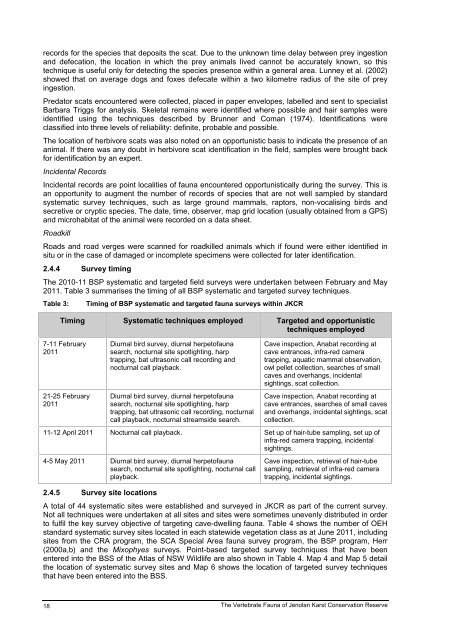The Vertebrate Fauna of Jenolan Karst Conservation Reserve: Final
The Vertebrate Fauna of Jenolan Karst Conservation Reserve: Final
The Vertebrate Fauna of Jenolan Karst Conservation Reserve: Final
Create successful ePaper yourself
Turn your PDF publications into a flip-book with our unique Google optimized e-Paper software.
ecords for the species that deposits the scat. Due to the unknown time delay between prey ingestion<br />
and defecation, the location in which the prey animals lived cannot be accurately known, so this<br />
technique is useful only for detecting the species presence within a general area. Lunney et al. (2002)<br />
showed that on average dogs and foxes defecate within a two kilometre radius <strong>of</strong> the site <strong>of</strong> prey<br />
ingestion.<br />
Predator scats encountered were collected, placed in paper envelopes, labelled and sent to specialist<br />
Barbara Triggs for analysis. Skeletal remains were identified where possible and hair samples were<br />
identified using the techniques described by Brunner and Coman (1974). Identifications were<br />
classified into three levels <strong>of</strong> reliability: definite, probable and possible.<br />
<strong>The</strong> location <strong>of</strong> herbivore scats was also noted on an opportunistic basis to indicate the presence <strong>of</strong> an<br />
animal. If there was any doubt in herbivore scat identification in the field, samples were brought back<br />
for identification by an expert.<br />
Incidental Records<br />
Incidental records are point localities <strong>of</strong> fauna encountered opportunistically during the survey. This is<br />
an opportunity to augment the number <strong>of</strong> records <strong>of</strong> species that are not well sampled by standard<br />
systematic survey techniques, such as large ground mammals, raptors, non-vocalising birds and<br />
secretive or cryptic species. <strong>The</strong> date, time, observer, map grid location (usually obtained from a GPS)<br />
and microhabitat <strong>of</strong> the animal were recorded on a data sheet.<br />
Roadkill<br />
Roads and road verges were scanned for roadkilled animals which if found were either identified in<br />
situ or in the case <strong>of</strong> damaged or incomplete specimens were collected for later identification.<br />
2.4.4 Survey timing<br />
<strong>The</strong> 2010-11 BSP systematic and targeted field surveys were undertaken between February and May<br />
2011. Table 3 summarises the timing <strong>of</strong> all BSP systematic and targeted survey techniques.<br />
Table 3: Timing <strong>of</strong> BSP systematic and targeted fauna surveys within JKCR<br />
18<br />
Timing Systematic techniques employed Targeted and opportunistic<br />
techniques employed<br />
7-11 February<br />
2011<br />
21-25 February<br />
2011<br />
Diurnal bird survey, diurnal herpet<strong>of</strong>auna<br />
search, nocturnal site spotlighting, harp<br />
trapping, bat ultrasonic call recording and<br />
nocturnal call playback.<br />
Diurnal bird survey, diurnal herpet<strong>of</strong>auna<br />
search, nocturnal site spotlighting, harp<br />
trapping, bat ultrasonic call recording, nocturnal<br />
call playback, nocturnal streamside search.<br />
Cave inspection, Anabat recording at<br />
cave entrances, infra-red camera<br />
trapping, aquatic mammal observation,<br />
owl pellet collection, searches <strong>of</strong> small<br />
caves and overhangs, incidental<br />
sightings, scat collection.<br />
Cave inspection, Anabat recording at<br />
cave entrances, searches <strong>of</strong> small caves<br />
and overhangs, incidental sightings, scat<br />
collection.<br />
11-12 April 2011 Nocturnal call playback. Set up <strong>of</strong> hair-tube sampling, set up <strong>of</strong><br />
infra-red camera trapping, incidental<br />
sightings.<br />
4-5 May 2011 Diurnal bird survey, diurnal herpet<strong>of</strong>auna<br />
search, nocturnal site spotlighting, nocturnal call<br />
playback.<br />
2.4.5 Survey site locations<br />
Cave inspection, retrieval <strong>of</strong> hair-tube<br />
sampling, retrieval <strong>of</strong> infra-red camera<br />
trapping, incidental sightings.<br />
A total <strong>of</strong> 44 systematic sites were established and surveyed in JKCR as part <strong>of</strong> the current survey.<br />
Not all techniques were undertaken at all sites and sites were sometimes unevenly distributed in order<br />
to fulfil the key survey objective <strong>of</strong> targeting cave-dwelling fauna. Table 4 shows the number <strong>of</strong> OEH<br />
standard systematic survey sites located in each statewide vegetation class as at June 2011, including<br />
sites from the CRA program, the SCA Special Area fauna survey program, the BSP program, Herr<br />
(2000a,b) and the Mixophyes surveys. Point-based targeted survey techniques that have been<br />
entered into the BSS <strong>of</strong> the Atlas <strong>of</strong> NSW Wildlife are also shown in Table 4. Map 4 and Map 5 detail<br />
the location <strong>of</strong> systematic survey sites and Map 6 shows the location <strong>of</strong> targeted survey techniques<br />
that have been entered into the BSS.<br />
<strong>The</strong> <strong>Vertebrate</strong> <strong>Fauna</strong> <strong>of</strong> <strong>Jenolan</strong> <strong>Karst</strong> <strong>Conservation</strong> <strong>Reserve</strong>

















